In this work a nanospike (subwavelength in diameter over its insertion length with a final tip diameter of ~150 nm) is inserted into the core of a HC-PCF where it becomes trapped at core-centre due to interaction with the guided mode in the HC-PCF and subsequent optomechanical back-action [Xie (2016)]. Fed by light launched into the untapered SMF, the guided fundamental mode spreads out into the surrounding space as it travels along the nanospike, adiabatically evolving into an eigenmode of "nanospike plus hollow core" structure. The presence of the hollow core strongly affects the local field profiles, leading to the appearance of an optical restoring force when the nanospike is moved away from the axis. The system offers a novel way to couple light from SMF to HC-PCF, with a demonstrated launching efficiency of 87.8% (the near-field mode image at the output end of the HC-PCF is shown in the inset of figure (a)) and a Fresnel reflection as low as ~0.05%. More importantly, it uniquely allows self-alignment and self-stabilization via the optomechanical trapping force. The coupling scheme uses no electronics, and the self-alignment/stabilization effect improves for higher laser powers, with potential applications in safely launching very high power laser light into HC-PCF for laser machining applications. We are also exploring the use of the technique to launch light into liquid-filled hollow core PCFs, with applications in microfluidic circuits.







